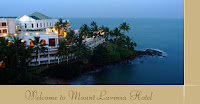COLOMBO
Colombo-the capital of Sri Lanka-is the largest city and main port of Sri Lanka. It is also the commercial and financial center of Sri Lanka. A bustling metropolis, the city is an attractive blend of old and new. It has the lazy charm of the bygone era combined with the verve and vivaciousness of a modern city. Colombo is an ideal location to start the Sri Lanka sojourn.
City Travel Guide
The Fort:
Pettah:
 Adjacent to Fort is Pettah-Colombo's leading bazaar district. It has narrow cobbled streets lined with shops and street stalls that offer the most fantastic bargains and the most unimaginable range of goods varying from bright printed fabrics, suitings, undergarments, children wear, footwear and handbags to electrical goods, semi precious jewellery, watches, rare first edition books, cutlery and other household items. Each criss-crossed lane of Pettah leads to the main street and each has developed its own specialized characteristic. For example, household goods are found on Keyzer Street. Prince Street is famous for glass, mirrors and electrical items. Malwatte Avenue sells English, Sinhala and Tamil music cassettes.
Adjacent to Fort is Pettah-Colombo's leading bazaar district. It has narrow cobbled streets lined with shops and street stalls that offer the most fantastic bargains and the most unimaginable range of goods varying from bright printed fabrics, suitings, undergarments, children wear, footwear and handbags to electrical goods, semi precious jewellery, watches, rare first edition books, cutlery and other household items. Each criss-crossed lane of Pettah leads to the main street and each has developed its own specialized characteristic. For example, household goods are found on Keyzer Street. Prince Street is famous for glass, mirrors and electrical items. Malwatte Avenue sells English, Sinhala and Tamil music cassettes.Galle Face Green:
A promenade on the sea face stretching one and a half kilometers, it is a relic of the British era. Laid out in 1859 it was used for horse racing. Today it is the largest open space in Colombo and a famous picnic spot.
Slave Island:
 On the south of Fort, is a long, narrow island-where the slaves had their night quarters-called Slave Island. Today the spot is surrounded by the remains of the former Beira Lake and is home to many office buildings, hotels and stores.
On the south of Fort, is a long, narrow island-where the slaves had their night quarters-called Slave Island. Today the spot is surrounded by the remains of the former Beira Lake and is home to many office buildings, hotels and stores. Mount Lavinia
Mount Lavinia is a beach just 12 km from Colombo. It was a famous beach even during the colonial times. The Governor's House built in 1805 by Sir Thomas Maitland now forms part of the famous Mount Lavinia Hotel.
Kelaniya Raja Maha Vihara:
It is a famous Buddhist temple and is believed to be at the spot where the Buddha preached 2000 years ago. It has an excellent carving of a reclining Buddha, and is the site for an annual perahera (religious procession) in January.
Dehiwala Zoo:
It is about 11 acres in extent and has very fine collection of fauna from all over the world. The highlight of the show is the elephant show, which is held every evening.
National Museum:
Housed in a grand colonial building, the National Museum is the custodian of Sri Lanka's cultural heritage. Among its exhibits are a vast collection of half a million books, more than 4000 archaic palm leaf manuscripts, rock sculptures from the ancient cities, bronze brassware and royal weapons of Sri Lankan kings, fascinating paintings of by gone eras and an excellent collection of antique demon masks. The most interesting among the exhibits are the regalia of the Kandyan Kings dating back to the 17th century.
The Viharamahadevi Park:
Located next to the National Museum, it is Colombo's largest park. The park is famous for its flowering trees, water channels and fountains.

Wolvendaal Church:
It is Colombo's oldest Dutch church. Its floor tiles are made from tombstones from the Dutch church in the Fort, and were brought here in 1813.
Hindu Temples:
There are several Hindu temples, which are called Kovils in Colombo. In the Sea Street in Colombo are several Hindu temples, the Ganeshan, the Old Kathiresan and the New Kathiresan with their colourful Gopurams (doorways). Other important temples are the Shiva Subramania Swami temple on Slave Island and the Sri Muthumariamman temple.













0 comments:
Post a Comment